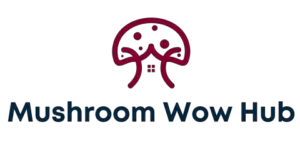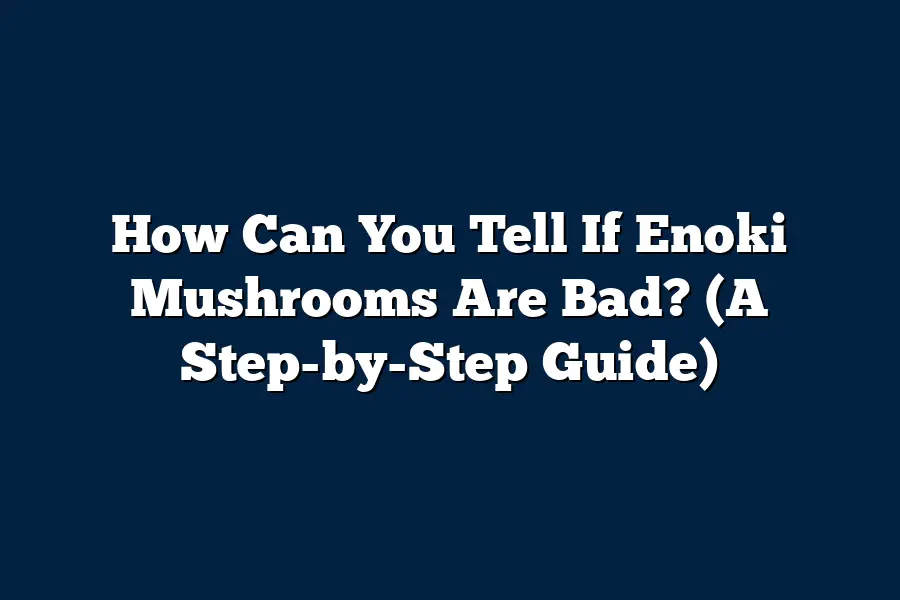To determine if enoki mushrooms are bad, look for signs of spoilage such as slimy or mushy texture, dark or discolored spots, or a foul odor. Fresh enoki mushrooms should have a firm texture, a bright white color, and a slightly earthy smell. If the mushrooms appear slimy, have dark spots, or emit a bad odor, it’s best to discard them to avoid any potential foodborne illness.
Wondering if those enoki mushrooms are still good to go?
Say no more!
In this guide, we’ve nailed down how to spot freshness or spoilage, along with expert storage tips.
Get set to level up your enoki game!
Table of Contents
How to Identify Fresh Enoki Mushrooms
When it comes to enjoying a delicious dish with enoki mushrooms, ensuring their freshness is crucial.
But how can you tell if your enoki mushrooms are still good to eat?
Let’s dive into some key indicators to help you identify fresh enoki mushrooms:
1. Appearance
Fresh enoki mushrooms should have a vibrant and firm appearance.
Here’s what to look out for:
– Color: Fresh enoki mushrooms should be bright white in color, with no signs of browning or discoloration.
– Texture: The stems of enoki mushrooms should be firm and slightly crunchy, while the caps should be smooth and intact.
2. Smell
A key indicator of freshness is the aroma of the enoki mushrooms.
Fresh enoki mushrooms should have a mild, earthy smell.
If you notice any unpleasant odors or a strong musty smell, it’s best to avoid consuming them.
3. Packaging
Check the packaging of the enoki mushrooms for signs of freshness:
– Sealed Packaging: If the enoki mushrooms are packaged, ensure the packaging is sealed without any punctures or tears.
– Expiration Date: Always check the expiration date on the packaging to ensure the mushrooms are within their shelf life.
4. Storage Conditions
Proper storage is essential to maintain the freshness of enoki mushrooms:
– Refrigeration: Store enoki mushrooms in the refrigerator between 32-36°F (0-2°C) to preserve their freshness.
– Ventilation: Ensure the mushrooms are stored in a well-ventilated container to prevent moisture buildup, which can lead to spoilage.
5. Mold or Discoloration
Inspect the enoki mushrooms closely for any signs of mold or discoloration:
– Mold: Discard enoki mushrooms if you notice any fuzzy white or green mold growth, as this indicates spoilage.
– Sliminess: Fresh enoki mushrooms should not feel slimy to the touch; if they do, it’s best to discard them.
By paying attention to these key indicators, you can easily identify whether your enoki mushrooms are fresh and safe to include in your next culinary creation.
Remember, when in doubt, it’s always best to err on the side of caution and discard mushrooms that show signs of spoilage.
Happy cooking!
Signs of Spoilage in Enoki Mushrooms
Wondering how to tell if your enoki mushrooms have gone bad?
It’s important to be able to recognize the signs of spoilage to ensure you’re consuming fresh and safe ingredients.
Let’s delve into the key indicators that your enoki mushrooms may no longer be at their best:
1. Sliminess
One of the most common signs that enoki mushrooms have spoiled is the presence of sliminess.
If you notice a slimy texture when touching the mushrooms or see a viscous film covering them, it’s best to discard them.
This sliminess indicates bacterial growth and decay, making the mushrooms unsuitable for consumption.
2. Discoloration
Fresh enoki mushrooms should have a crisp white appearance.
Any discoloration, such as browning or dark spots, could signify spoilage.
Discolored patches on the mushrooms indicate oxidation and deterioration, rendering them unsafe to eat.
3. Unpleasant Odor
Fresh enoki mushrooms have a mild, earthy scent.
However, if you detect a strong, unpleasant odor when sniffing the mushrooms, it’s a clear indication that they have gone bad.
Mold or bacterial growth can cause a foul smell, warning you to avoid consuming the mushrooms.
4. Slimy Caps
Inspect the caps of the enoki mushrooms closely.
If you see slimy or mushy caps, it’s a definite sign of spoilage.
The sliminess on the caps indicates decay and bacterial contamination, making the mushrooms unfit for cooking or eating.
5. Wet or Mushy Texture
Healthy enoki mushrooms should feel firm and dry to the touch.
Mushrooms that appear wet, soggy, or mushy are likely past their prime.
The loss of firmness and the presence of excessive moisture indicate spoilage, and it’s best to discard such mushrooms.
6. Storage Conditions
Improper storage can also contribute to the spoilage of enoki mushrooms.
If the mushrooms have been stored in a damp or humid environment for an extended period, they are more susceptible to contamination and decay.
Always store enoki mushrooms in a cool, dry place to maintain their freshness and quality.
By being observant of these signs of spoilage, you can ensure that you only use fresh and safe enoki mushrooms in your culinary creations.
Stay tuned for more tips on handling and storing mushrooms to maximize their shelf life and flavor profile.
Proper Storage Techniques for Enoki Mushrooms
When it comes to ensuring the freshness and quality of your enoki mushrooms, proper storage techniques play a crucial role.
Improper storage can lead to the mushrooms going bad quickly, resulting in a waste of food and money.
To help you make the most out of your enoki mushrooms, here are some essential storage tips to keep in mind:
1. Refrigeration:
Enoki mushrooms are best stored in the refrigerator to maintain their freshness.
Here’s how you can do it effectively:
– Remove the mushrooms from the original packaging.
– Place the mushrooms in a paper bag or a loosely closed plastic bag to allow for air circulation.
– Store the bag in the refrigerator crisper drawer to maintain a consistent temperature.
2. Temperature and Humidity:
Maintaining the right temperature and humidity levels is key to preserving the quality of enoki mushrooms.
– Keep the refrigerator temperature between 32°F to 38°F (0°C to 3°C) for optimal storage.
– Enoki mushrooms thrive in high humidity, so consider placing a damp paper towel in the storage bag to help retain moisture.
3. Avoid Moisture:
Excess moisture can cause enoki mushrooms to become slimy and spoiled.
To prevent this:
– Check the mushrooms regularly for any signs of dampness or condensation in the storage bag.
– Replace the damp paper towel if needed to maintain the right moisture levels.
– If you notice any moisture buildup, pat the mushrooms dry with a paper towel before returning them to the refrigerator.
4. Use Them Promptly:
While proper storage techniques can extend the shelf life of enoki mushrooms, it’s best to use them promptly for the freshest flavor and texture.
– Try to use the mushrooms within 3 to 5 days of purchase or harvest for the best results.
– Incorporate enoki mushrooms into your meals to enjoy their unique taste and nutritional benefits before they start to deteriorate.
By following these storage guidelines, you can ensure that your enoki mushrooms stay fresh and flavorful for longer, allowing you to enjoy them to the fullest in your culinary creations.
Safety Considerations When Dealing with Spoiled Mushrooms
Are you a fan of enoki mushrooms but unsure how to tell if they’re past their prime?
It’s crucial to understand the safety considerations when dealing with spoiled mushrooms to avoid any potential health risks.
Let’s dive into some essential tips to spot bad enoki mushrooms:
1. Visual Inspection
The first step in determining if your enoki mushrooms have gone bad is to visually inspect them.
Look for any of the following signs:
- Discoloration: If the mushrooms appear darkened or have developed brown spots, it’s a clear indication that they are no longer safe to eat.
- Slimy Texture: Touch the mushrooms lightly. If they feel slimy or excessively moist, it’s a sign of spoilage.
- Mold Growth: Any visible mold on the mushrooms is a definite red flag. Discard them immediately to avoid foodborne illnesses.
2. Unpleasant Odor
A fresh batch of enoki mushrooms should have a mild, earthy aroma.
If you detect any sour, ammonia-like, or generally unpleasant smell coming from the mushrooms, it’s best to err on the side of caution and dispose of them.
3. Expiration Date
Check the expiration date on the packaging or use-by date if applicable.
Consuming enoki mushrooms past their expiration date can pose health risks, so make sure to adhere to the recommended timeline.
4. Storage Conditions
Improper storage can accelerate the spoilage process of mushrooms.
Enoki mushrooms should be stored in a cool, dry place to maintain their freshness.
If you notice that the mushrooms have been stored at room temperature for an extended period, they may have already gone bad.
5. Allergic Reactions
In some cases, consuming spoiled mushrooms can lead to allergic reactions or food poisoning.
If you experience any symptoms such as nausea, vomiting, diarrhea, or stomach cramps after consuming enoki mushrooms, seek medical attention immediately.
By following these safety considerations when dealing with spoiled enoki mushrooms, you can protect yourself and your loved ones from the potential risks associated with consuming contaminated food.
Remember, when in doubt, it’s always safest to discard mushrooms that show any signs of spoilage.
Final Thoughts
Knowing how to distinguish between fresh and spoiled enoki mushrooms is a crucial skill for any home cook or mushroom enthusiast.
By following the step-by-step guide outlined in this article, you are now equipped with the knowledge to ensure that your enoki mushrooms are always at their best.
Remember to trust your senses – sight and smell are powerful tools in determining the quality of your mushrooms.
As you embark on your culinary adventures with enoki mushrooms, make sure to practice proper storage techniques to keep them fresh for longer.
Your taste buds will thank you for the delicious meals that fresh enoki mushrooms can bring to your table.
Lastly, always prioritize your health and safety when it comes to handling mushrooms.
The risks associated with consuming spoiled mushrooms are not worth the gamble.
If in doubt, throw it out.
Now, armed with this valuable information, take a moment to inspect your enoki mushrooms and put your newfound knowledge into practice.
Your next meal can be a masterpiece with the assurance that your enoki mushrooms are fresh and safe to eat.
Happy cooking!

